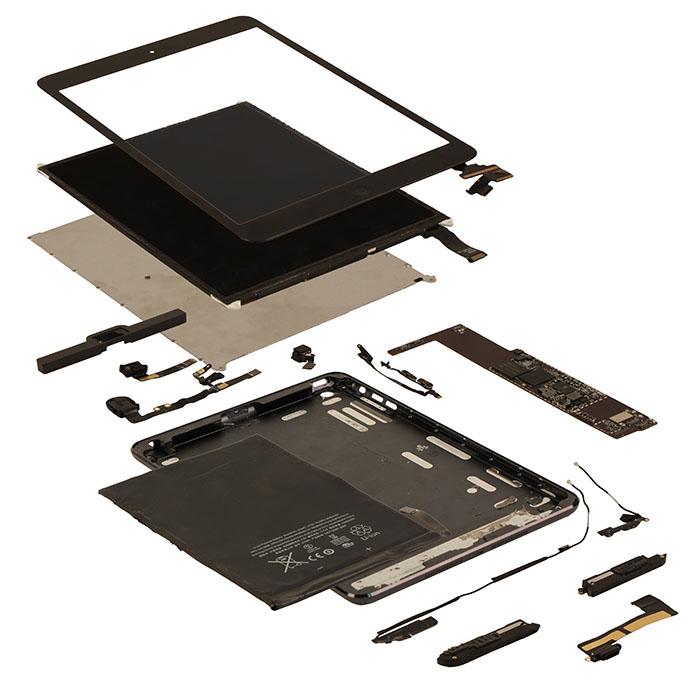With Apple rumored to be working on a next-generation iPad mini with Retina display, some market watchers estimate that adding the high-resolution panel to the 7.9-inch tablet could raise total parts costs by up to 30 percent.
According to commentary from DigiTimes, Apple's inclusion of a Retina display suitable for the iPad mini would raise the product's overall bill of materials by more than $12, bringing the overall tally to above $200 per unit. While the publication has been hit-or-miss with Apple hardware rumors in the past, its track record with display-centric reports has been fairly accurate.
If Apple adopts the Retina display, not only will the cost of the panel increase, but other parts as well, including an upgraded LED backlight to compensate for the increased pixel density. All told, the Retina display is estimated to raise the iPad mini's BOM by more than 30 percent.
Research firm IHS iSuppli in November conducted a teardown of the then-new iPad mini and estimated the 7.9-inch tablet's innards to cost Apple $188. Without factoring in labor costs, the low-end 16GB Wi-Fi only model is yielding 43 percent profit margins on the high end, with the 32GB and 64GB versions bringing in margins of up to 52 percent and 56 percent, respectively.
Of the components, the iPad mini's screen was the most expensive item at $80, representing about 43 percent of the total BOM. Costs for the panel are likely to have decreased due to increased production ramp.
It is unclear if Apple will raise the price of the iPad mini if and when the company decides to release a Retina display model, though when an identical spec bump came to the 9.7-inch iPad, consumer cost remain unchanged.
The publication goes on to say that the global market is looking to move 180-240 million 7-inch form factor tablets in 2013, accounting for 45-60 percent of total shipments.
 Mikey Campbell
Mikey Campbell








 Christine McKee
Christine McKee
 Marko Zivkovic
Marko Zivkovic
 Mike Wuerthele
Mike Wuerthele

 Amber Neely
Amber Neely
 Sponsored Content
Sponsored Content
 Wesley Hilliard
Wesley Hilliard









40 Comments
Assumed, mythical number to increase (maybe) should assumed (presently mythical) parts exist.
Which is precisely why it won't happen in 2013. The iPad mini is supposed to be an upsell from budget android tablets. Adding a retina display to the mini at this point will remove the distinguishing feature that makes people pay more for a full-sized iPad. I predict they will keep the mini more or less as is and use manifacturing ramp to drop the price while maintaining margin. The US$329 starting price is just too weird to not have been purposely within striking distance of US$299. An iPad for $300 is huge news. Based on the backplate leak We already know Apple are working hard to make the iPad 5 more like the mini - specifically addressing the most common complaints about the full size iPad: heavy, thick and cumbersome. Apple owns the centre of the market. It's fairly clear that their focus has to be on stopping encroachment by competitors at the bottom and top ends of the market. They can only do this by spreading out, not contracting, their price points. 7" Droids Microsoft Surface/Ultrabooks
30% extra cost for 100% more pixels. I'll buy.
I still think 2014 is most likely for that thickness and weight with the current iPad mini being the maximum allowed but I sure it hope it arrives this year. [quote name="Tallest Skil" url="/t/156049/bringing-retina-display-to-ipad-mini-could-add-30-to-total-parts-cost#post_2279767"]Assumed, mythical number to increase (maybe) should assumed (presently mythical) parts exist. [/quote] ...and that previous mythical numbers are accurate.
Which is precisely why it won't happen in 2013
It can still happen by charging $399 instead of $329 for the retina iPad mini. The current iPad mini will become $299, while the normal iPad 5 will be starting $499.
I don't think AAPL can afford to sit there doing nothing major when others are producing 5" 1080p smartphones ....